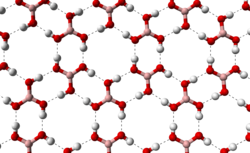

In chemistry, the term chicken wire is used in different contexts. Most of them relate to the similarity of the regular hexagonal (honeycomb-like) patterns found in certain chemical compounds to the mesh structure commonly seen in real chicken wire.


In chemistry, the term chicken wire is used in different contexts. Most of them relate to the similarity of the regular hexagonal (honeycomb-like) patterns found in certain chemical compounds to the mesh structure commonly seen in real chicken wire.
Polycyclic aromatic hydrocarbons or graphenes —including fullerenes, carbon nanotubes, and graphite —have a hexagonal structure that is often described as chicken wire-like. [1] [2] [3]

A hexagonal structure that is often described as chicken wire-like can also be found in other types of chemical compounds such as:


The skeletal formula is a method to draw structural formulas of organic compounds where lines represent the chemical bonds and the vertices represent implicit carbon atoms. [9] This notation is sometimes called chicken wire notation by a Stanford professor. [10] [11] [12]

It is an old joke[ dubious – discuss ] in chemistry to draw a polycyclic hexagonal chemical structure and call this fictional compound chickenwire.[ citation needed ] By adding one or two simple chemical groups to this skeleton, the compound can then be named following the official chemical naming convention. An example is 1,2-Dimethyl-chickenwire in a cartoon by Nick D. Kim.

In computational chemistry a chicken wire model or chicken wire surface plot is a way to visualize molecular models by drawing the polygon mesh of their surface (defined e.g. as the van der Waals radius or a certain electron density).[ citation needed ]
{{cite journal}}: CS1 maint: numeric names: authors list (link)